Each evening, the sky is adorned with numerous twinkling stars. If you enjoy gazing at the nighttime sky, you can easily spot several constellations and maybe even planets. However, not all stars possess designated names. Or do they?

Even in the absence of telescopes or any other visual aids, we are still able to observe numerous stars in the dark night sky, far from the glow of urban areas. This prompts us to wonder: what are the designations of all these celestial bodies?
What are the various names given to stars?
Throughout history, stars in the night sky have been given names that are still in use today. However, in modern astronomy, stars are typically assigned alphanumeric designations for cataloging purposes.
These designations can vary across different catalogs. For instance, the brightest star in the constellation Lyra is known as Vega, but it is also designated as Alpha Lyra (in the Bayer system), 3 Lyra (in the Flemsteed system), HR 7001 (in the Yale Bright Star Catalog), and has other names in various catalogs.
Names of stars in the correct way
“Proper names” of stars are those that have either been in existence since ancient times or have been designated by various organizations within the International Astronomical Union (IAU). The oldest proper names mostly originate from ancient Greek. For instance, Sirius, Procyon, and Arcturus are all ancient Greek proper names. However, the majority of proper names for stars have Arabic origins, as they were given by Arab astronomers during the Middle Ages. These names are accompanied by numerous legends and origin stories that are based on the stars’ positions within their constellations. One example of such a name is Deneb, which is derived from the Arabic term for “tail of the bird” because the star is located in the Constellation of the Swan. Nowadays, assigning individual names to each star is a cumbersome task, involving extensive paperwork. There have even been instances where multiple stars have been given similar proper names. In some cases, the meaning of star names was lost when Arabic names were translated into other languages like Latin.
Bayer’s Star Catalog
In 1600, Johannes Bayer released his star catalog, which featured a unique method of labeling stars within constellations. Using lowercase Greek letters, Bayer assigned labels based on the stars’ brightness, with the brightest star being labeled “Alpha,” the second brightest as “Beta,” and so on. Each Greek letter was then followed by the Latin genitive case of the constellation name.
For instance, the brightest star in the constellation Canis Major, known as Sirius, was designated as Alpha Canis Majoris. Similarly, within the constellation Centaurus, the two brightest stars were labeled as Alpha Centauri and Beta Centauri.
However, Bayer did not always adhere to his own system of assigning brightness. In the case of the Big Dipper, he simply labeled the stars using Greek letters in sequential order from west to east. Another inconsistency was found in the constellation Gemini, where he labeled the first and second brightest stars as “Beta Gemini” and “Alpha Gemini” respectively. Since the Greek alphabet only has 24 letters, Bayer attempted to solve this issue by using lowercase Latin letters “a-z” to designate stars 25th through 50th, and then using uppercase Latin letters “A-Z” for stars 51st through 76th. However, these alternative schemes are not widely adopted.
Flemsteed Atlas
After two centuries since Bayer’s initial introduction of his classification system, John Flemsteed devised his own numerical classification system. In this particular arrangement, the stars within each constellation are assigned numbers in a sequential order from west to east. As a result, the star positioned furthest to the west in the Taurus constellation is denoted as 1 Taurus, while the subsequent star to the west is labeled as 2 Taurus, and so forth. Over 2,600 stars have been assigned Flemsteed numbers.
The Bayer and Flemsteed designations are used to identify the prominent and bright stars within a constellation. However, as more faint stars were discovered, a new system had to be developed to label these stars. To accomplish this, new catalogs were created based on the star’s position in the sky, using a coordinate system similar to Earth’s latitudes and longitudes, without considering the parent constellation. One widely used catalog in astronomy is the Yale Catalog of Bright Stars. In this catalog, stars are designated with either ‘HR’ or ‘BS’ followed by a four-digit number. The ‘HR’ stands for ‘Harvard Revised’ because Harvard University initially conducted the cataloging before Yale University took over publishing it. The catalog contains approximately 9,110 stars, with examples of this classification including HR 2326 (also known as Canopus) and HR 7001 (also known as Vega).
Another commonly used catalog in the field of astronomy is the Henry Draper (HD) catalog. This particular catalog utilizes the celestial coordinates of stars and includes a comprehensive list of over 225,000 stars. Each star in this catalog is identified by the letter “HD” followed by a unique six-digit number. However, it is important to note that there are numerous other catalogs available as well. For example, there is the Smithsonian Astrophysical Observatory (SAO) catalog which is organized by observatory, as well as the Hubble Space Telescope (GSC) catalog. These are just a few examples, as there are many other catalogs in existence. To gain a better understanding of the vast number of star designations present today, we can examine the various classifications assigned to Betelgeuse, the second brightest star in the Orion constellation. Betelgeuse is known by multiple designations, including Alpha Orion (Bayer designation), 58 Orion (Flemsteed designation), HR2061 (Yale University Bright Star Catalog), HD39801 (Henry Draper catalog), BD+7 1055 (Bonner Durchmusterung catalog), and SAO113271 (Smithsonian Astrophysical Laboratory catalog).
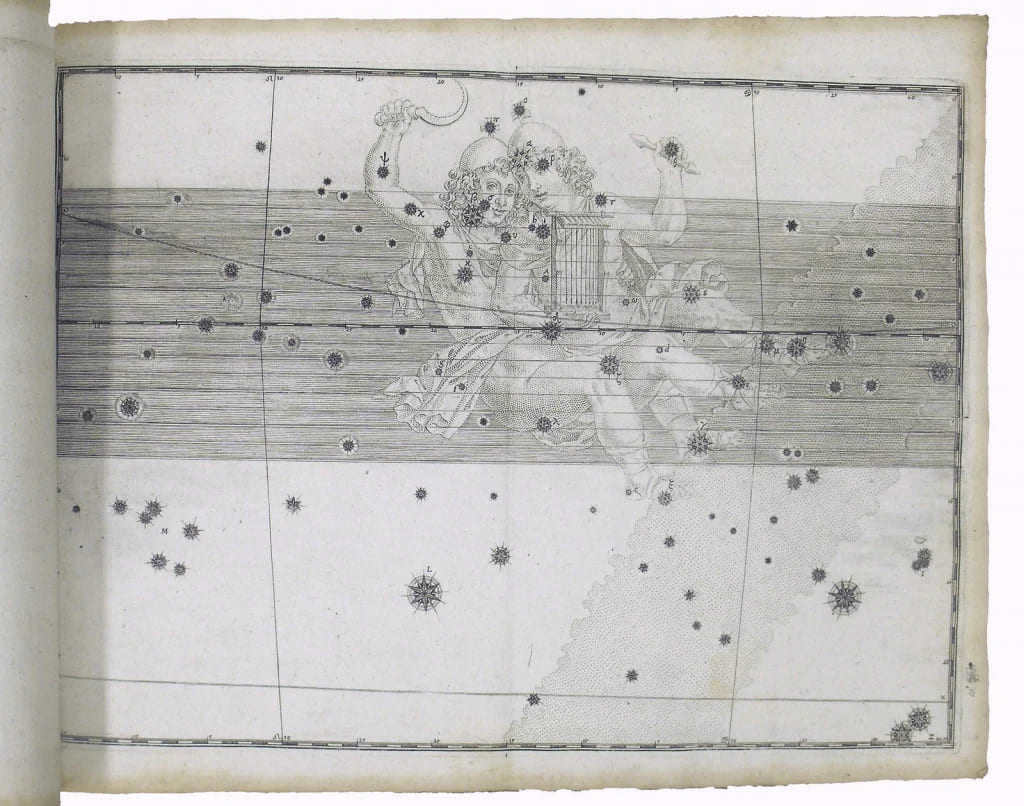
The night sky is filled with countless stars, and astronomers have come up with various methods to distinguish them from one another.
Anyone who has spent a whole night gazing at the sky has surely been captivated by the magnificent display of stars, planets, clusters, and even galaxies. Those who have some experience observing the night sky may even be able to identify some of the more prominent stars.
There are an immense number of stars up there; even without the use of telescopes or other optical tools, we can see hundreds of them in the clear night sky away from the brightness of city lights.
This leads us to wonder: how are all these stars named and distinguished?
To answer this question, we must first delve into a brief historical journey of how people have named the stars throughout the centuries.
Nevertheless, in contemporary professional astronomy, stars receive alphanumeric designations that are utilized in all authoritative catalogs.
As an illustration, the most luminous star in the constellation Lyrae is referred to as Vega, however it is also designated as Alpha Lyrae (according to Bayer), 3 Lyrae (according to Flamsteed), HR 7001 (as per the Yale Bright Star Catalog), and has other names in numerous other catalogs. In this article, we will explore the various forms of star names and designations that are currently employed.
Names of Stars
Let’s start by exploring the names given to stars. These names, known as “proper names,” can be traced back to ancient times, more recent eras, or have been assigned by various organizations under the International Astronomical Union (IAU). The oldest proper names mostly originate from ancient Greece.
For instance, Sirius, which means “burning,” Procyon, derived from the Greek term “προ κύων” meaning “before the dog,” and Arcturus, known as the “bear chaser,” as it seems to follow the Ursa Major constellation, also known as the Big Dipper.
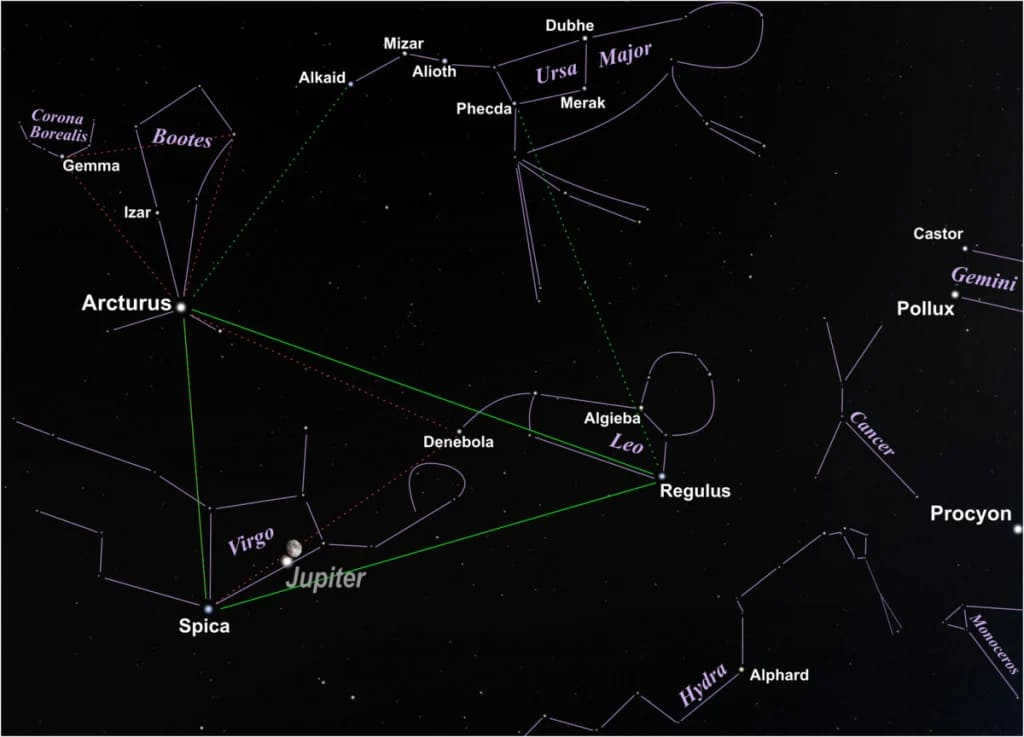
However, the majority of the proper names given to stars have their roots in the Arabic language, as they were assigned by astronomers from the Arab world during the Middle Ages. These names are steeped in legends and origin tales that are based on the position of the stars within their respective constellations. Notable examples of such names include Deneb, which translates to “tail of the bird,” Aldebaran, which means “follower” in reference to its position in the Pleiades star cluster, and Fomalgaut, which signifies “mouth of the southern fish.”
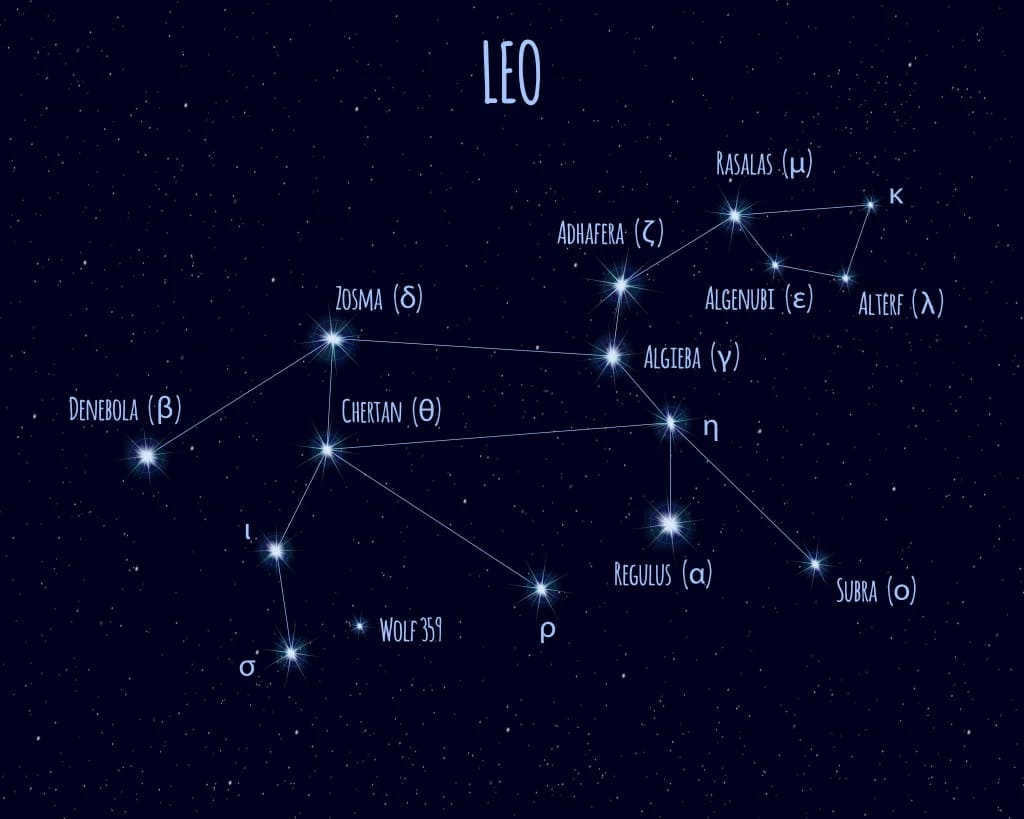
Assigning a suitable name to each individual star can be a laborious task. Not only does it require extensive paperwork, but there have been instances where multiple stars have been given identical names: “Deneb” in the Swan constellation, “Denebola” in the Leo constellation, and “Deneb Caitos” in the Cetus constellation. Occasionally, when Arabic names were translated into other languages like Latin, the original meaning of the star’s name was lost.
Early attempts at star naming
In 1600, Johann Bayer published his star name catalog. He utilized lowercase Greek letters to indicate stars in descending order of brightness within the same constellation. Consequently, the brightest star in a constellation was referred to as “Alpha”, the second brightest as “Beta”, and so forth. The Greek letter was then followed by the Latin genitive case of the constellation name.
For instance, the brightest star in the Big Dog constellation, Sirius, was denoted as “Alpha Canis Majoris”, and the Latin genitive case “Canis Majoris” simply meant “of Canis Majoris”. Similarly, in the Centaurus constellation, the first and second brightest stars were named “Alpha Centauri” and “Beta Centauri”, respectively.
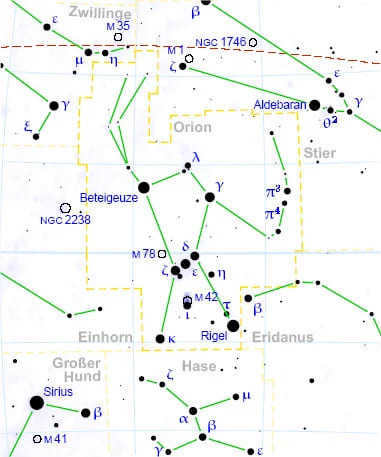
However, Bayer did not consistently adhere to his own system of brightness classification. When it came to the Big Dipper constellation, he simply assigned Greek letters to the stars in sequential order from west to east. Another inconsistency was found in the Gemini constellation, where he labeled the first and second brightest stars as “Beta Geminorum” and “Alpha Geminorum,” respectively.
Additionally, Bayer encountered a limitation in the number of Greek letters available, as there are only 24. To address this issue, he attempted to incorporate lowercase Latin letters “a-z” to number stars 25th through 50th, and then uppercase Latin letters “A-Z” for stars 51st through 76th. However, these alternative schemes did not gain widespread acceptance.
Two centuries after Bayer’s initial implementation, John Flamsteed devised his own unique system for classifying stars. In his innovative approach, each star within a constellation is assigned a numerical designation based on its position from west to east. As a result, the furthest western star in the Taurus constellation became known as 1 Taurus, while the subsequent stars were labelled as 2 Taurus, and so forth. It is important to note that the Flamsteed number is accompanied by the Latin genitive form of the constellation’s name. In total, over 2600 stars have been assigned Flamsteed numbers.
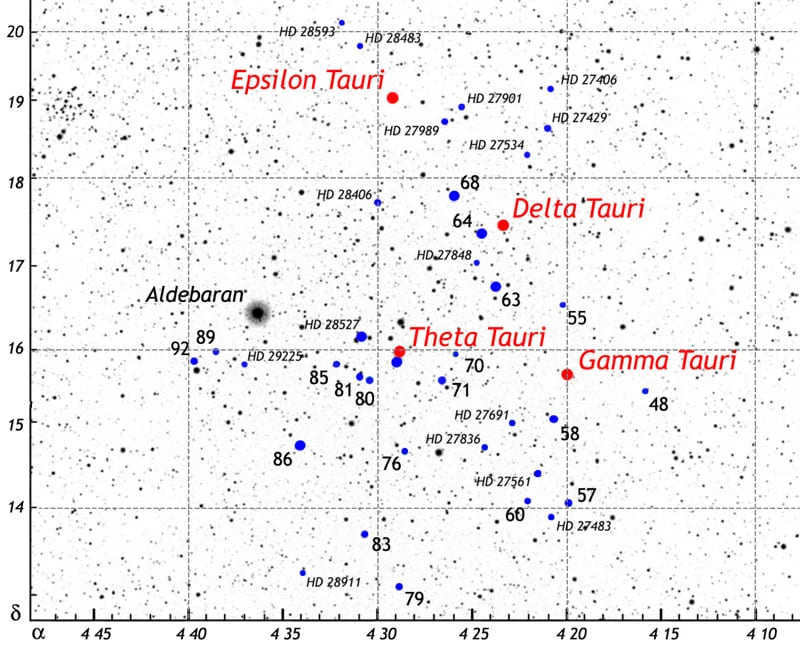
The designations assigned by Bayer and Flamsteed are used to identify the most brilliant and notable stars within a constellation. As more faint stars were observed and documented, it became imperative to establish a fresh classification system for their identification. In order to achieve this, updated catalogs were created, taking into account the star’s celestial coordinates (which resemble the latitude and longitude lines on Earth), disregarding the association with their respective constellations.
Star catalogs
One of the most widely used catalogs in astronomy is the Yale Bright Star Catalog. The stars in this catalog are identified as ‘HR’ or ‘BS’ followed by a four-digit number. In this case, ‘HR’ stands for ‘Harvard Revised’, as the cataloging was initially conducted by Harvard before Yale took over its publication. The catalog contains approximately 9110 stars, with some examples of this classification being HR 2326 (known as Canopus) and HR 7001 (known as Vega).
A popular catalog in the field of astronomy is the Henry Draper (HD) catalog. This catalog is also based on the celestial coordinates of stars and includes more than 225,000 stars. Each star in the HD catalog is identified by the designation “HD” followed by a unique 6-digit number. Additionally, this catalog provides data on the spectral classes of the stars, which indicates the type of radiation they emit. The HD catalog encompasses a wide range of stars, including both bright and dim ones.
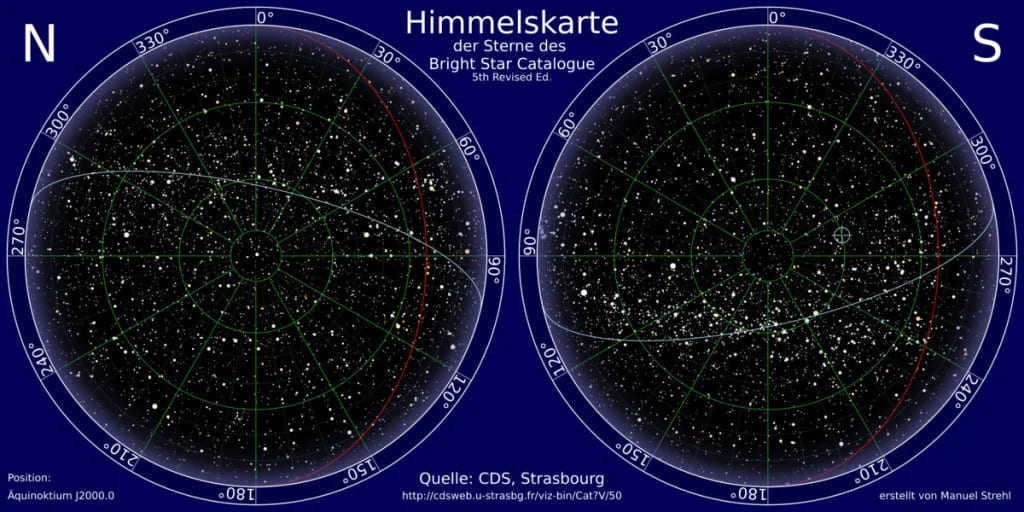
The Durchmusterung catalogs are well-known for their identification of faint stars. These catalogs contain a comprehensive list of stars that are 50 times dimmer than what can be observed with the naked eye. Examples of such catalogs are the Bonner Survey (known as “Bonner Durchmusterung” in German) and the Cordoba Survey (known as “Cordoba Durchmusterung” in German).
Other commonly utilized catalogs include the Smithsonian Astrophysical Observatory (SAO) catalog, the Positions and Proper Motions (PPM) catalog, and the Guide Star Catalog (GSC) from the Hubble Space Telescope.
Binary and Variable Stars
Up until now, catalogs have primarily focused on individual stars with a consistent magnitude (or the star’s brightness as seen from Earth). Nevertheless, there exist binary or multiple stars (comprised of two or more stars in close proximity, potentially gravitationally connected) as well as variable stars (stars that exhibit fluctuations in brightness over time).
When it comes to double or multiple stars, a common method of labeling them is to assign an uppercase Latin letter to each star based on its brightness. Typically, the primary star is labeled with an ‘A’ followed by the corresponding Latin letter for companion stars. For instance, the brightest star in the sky, Sirius, is designated as Sirius A, while its companion star is designated as Sirius B.
In the case of variable stars, Friedrich Wilhelm Argelander proposed a labeling system using the remaining letters from Bayer’s system.
Considering that the farthest Bayer had advanced in his classification was “Q”, the initial variable star detected in a constellation ought to be “R”, then “S”, and so forth. Once “Z” had been exhausted, the utilization of double letter designations was introduced: “RR”, “RS”, all the way to “ZZ”. As more variable stars were identified, astronomers started to assign labels from “AA”, “AB”, “BA”, all the way to “QZ”. An instance of this pattern is the star designated as R in the constellation of Swan, since it was the first variable star found in the constellation of Cygnus.
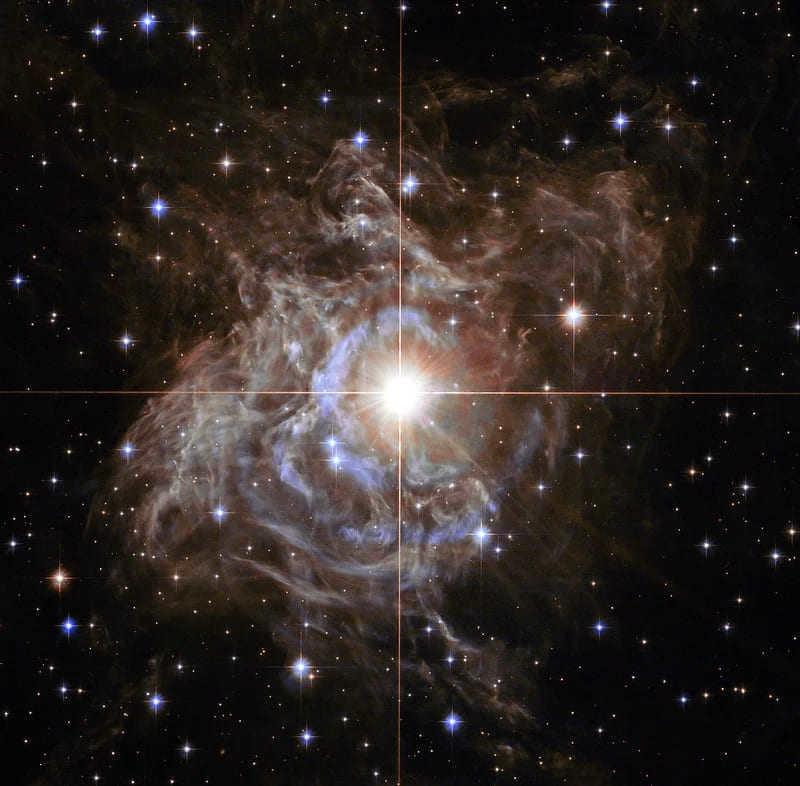
Following that, astronomers started using the letter V followed by a three-digit numeral to designate variable stars. For instance, V335 in the constellation Taurus is a variable star that adheres to this naming convention.
Naming and cataloging stars is a crucial aspect of contemporary astronomy. By assigning names to stars, it becomes easier to study their properties and characteristics, as more observations lead to more stars. In certain cases, cataloging can even provide information such as the star’s position in the sky. Additionally, the aforementioned designation systems are employed to identify new classes of stars.
This is particularly applicable to variable stars. Humans have made significant progress in the study of stars and star systems, and the act of naming stars plays a vital role in our comprehension and admiration of the wonders of the cosmos.
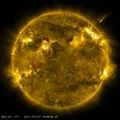
The majority of the detectable material in galaxies is found in stars. Stars are highly energetic entities. Specifically, life on Earth owes its survival to the radiation emitted by the Sun. A star’s composition is primarily made up of ionized plasma, with the core being either partially or completely ionized. As a star progresses through its life cycle, the material within its core may transition into a degenerate gas state (in the case of degenerate stars) or neutron matter (in the instance of neutron stars).
Stars are not evenly spread out in space, but instead come together to form various types of stellar systems. These systems include double stars, multiple stars, star clusters, and galaxies. The smallest systems consist of two or more stars, while larger systems called star clusters can contain anywhere from a few dozen to millions of stars. The biggest systems of stars are known as galaxies. Our own stellar system, the Galaxy, is home to several hundred billion stars.
In order to make it easier to navigate the night sky, astronomers have divided the celestial sphere into constellations. Each individual star within a constellation is given a designation, either using letters from the Greek and Latin alphabets or a combination of letters and numbers, as outlined in star catalogs.
The majority of stars remain in a state of rest, meaning that no alterations in their physical attributes are detected over time. Nevertheless, there exist stars that undergo noticeable transformations, known as non-stationary stars (including variable stars). Certain variable stars undergo regular shifts, while others experience irregular changes. Among these stars are new stars, which occasionally emit bursts of radiation. During supernova outbursts, a significant portion (and sometimes all) of the star’s material can be dispersed into outer space.
The study of stars: a concise historical overview
Key features of stars
Stars possess both apparent (observable) and true (intrinsic) characteristics. The observed features are influenced by the star’s properties, the distance between the star and the observer, the properties of interstellar matter, and the observation methods and instruments employed. The primary observable characteristic of a star is its luminosity, typically measured using a logarithmic scale of stellar magnitudes. For instance, Sirius, the most brilliant star visible at night, shines hundreds of times brighter than the faintest stars detectable with the unaided eye.
Stars have different spectral compositions of radiation, which means that the brightness of a star is influenced by how it is measured. In modern astrophotometry, stars are measured in various regions of the spectrum, including ultraviolet (U), blue (B), visual (V), red (R), infrared (I), and others. The difference in brightness between adjacent regions of the spectrum is known as the color index, which provides a quantitative measure of a star’s color. A higher color index indicates a redder star with a lower surface temperature. Additionally, the distance of a star from Earth affects its apparent brightness. The closer a star is, the brighter it appears and the more light it illuminates at the Earth’s surface.
The luminosity of a star can only be calculated if both the apparent brightness and the distance to the star are known. In cases where the distance is unknown, an estimate of the luminosity can be made using approximate empirical relationships. Therefore, the temperature of stars is a determining factor for their luminosity. Furthermore, for variable stars such as Cepheids, the pulsation period is dependent on the luminosity.
The classification of stars based on their spectral characteristics is of utmost significance in the field of astrophysics. The spectral classes are determined through empirical observations of various features present in the star’s spectrum. These classes primarily indicate the temperature of the star’s surface, which in turn affects the excitation and ionization of atoms, thus determining the presence and intensity of specific lines in stellar spectra. The classes are traditionally denoted using uppercase Latin letters. The main spectral classes, namely O, B, A, F, G, K, M, and L, are arranged in descending order of the star’s surface temperature. The hottest stars, with temperatures reaching up to 50,000 K, fall under the class O and are characterized by a blue color, while the coolest stars, with temperatures ranging from 2,000 to 3,000 K, are categorized under the classes M and L and are identified by their red hue.
The primary characteristics of a star include its luminosity (L), mass (M), and radius (R). These parameters are typically expressed in units relative to the Sun’s luminosity (L☉ = 3.85 × 1026 W), mass (M☉ = 1.99 × 1030 kg), and radius (R☉ = 6.96 × 108 m).
If the chemical composition of all stars were the same, their luminosity and radius would depend solely on the mass of the star. However, as stars undergo thermonuclear reactions throughout their evolution, the distribution and composition of chemical elements within them change over time. In young stars and in the outer layers of all stars, hydrogen (72-75% by mass) and helium (23-25%) are the dominant elements. Other elements, such as oxygen, nitrogen, iron, carbon, and neon, are also present in small quantities (0.001 to 4%) and in similar proportions to those found on Earth. As stars age, their structure becomes more complex, with a dense core primarily composed of helium and a surrounding shell that retains the original chemical composition.
The masses of stars have only been directly determined for the Sun and a few double stars, using Kepler’s laws to calculate their masses. Indirectly, the masses of stars can be estimated by analyzing the mass-luminosity ratio or the star’s spectrum. Current data suggests that the masses of stars range from approximately 0.1 solar masses to 100 solar masses.
The sizes of stars are determined directly for binary star systems in which one star periodically blocks the other. Additionally, the sizes of a small number of nearby stars have been determined using interferometry and speckle interferometry. The sizes of stars range from 0.01 solar radii (for white dwarfs) to even a few kilometers (for neutron stars), all the way up to 100 – 1000 solar radii for supergiants.
Because stars don’t emit radiation like a pure black body, the energy distribution in a star’s spectrum can’t be described by a single temperature. As a result, the surface temperature (photosphere) of a star, determined from observed radiation, varies depending on the method used to calculate it. The main parameter is the star’s effective temperature (T_e), which is the temperature the star’s surface would have if it radiated like a pure black body with the same luminosity. The energy flux (ε) from a unit of the star’s surface is related to T_e by the Stefan-Boltzmann radiation law: ε = σT_e^4 (where σ is the Stefan-Boltzmann constant). Therefore, given the star’s luminosity and radius, one can calculate T_e and vice versa. Alternatively, T_e can be determined from the star’s spectral class. The total luminosities of stars (across the entire electromagnetic spectrum) range from 10^-4 L_⊙ (faint dwarfs) to 10^6 L_⊙ (hot supergiants).
The prolonged maintenance of high luminosity in stars is a clear indication of the immense energy being emitted from within. Contemporary physics identifies two potential sources of this energy within a star – gravitational contraction, resulting in the release of gravitational energy, and thermonuclear reactions, which fuse atomic nuclei of lighter chemical elements to create nuclei of heavier elements, subsequently releasing vast amounts of energy.
According to calculations, the energy produced by gravitational compression would only be enough to sustain the Sun’s brightness at its current level for 30 million years. However, geological and other evidence indicates that the Sun’s brightness has remained relatively constant for billions of years. Gravitational compression may only be a source of energy for the youngest stars, such as T Taurus-type stars. Thermonuclear reactions occurring at temperatures between 5 and 100 million Kelvin are the only ones capable of maintaining a star’s brightness at its observed level. Inside a star with such temperatures and immense densities, the gas exerts a pressure of billions of atmospheres. In these extreme conditions, a star can only maintain equilibrium because the pressure from gas (and radiation) that pushes it to expand is counteracted by gravitational forces that compress it. This state is known as hydrostatic equilibrium. Therefore, a stable star can be compared to a plasma sphere in a state of hydrostatic equilibrium.
If the temperature within a star increases, it will expand as the pressure within its core rises. Consequently, the temperature, density, and pressure of the gas will decrease, causing the star to return to a state of equilibrium. The relationship between the size of the star and the temperature within its core can be expressed as follows: the temperature T T T in the center of the star is directly proportional to the ratio of the star’s mass M M M to its radius R , R , R , i.e. T ∼ M / R . T \sim M / R . T ∼ M / R . All of these characteristics apply to chemically homogeneous main-sequence stars . Red giants, on the other hand, consist of a compact, high-temperature core (composed of helium or carbon-oxygen) and a more spread-out, relatively cooler, and less dense envelope. Chemically inhomogeneous models have been developed to describe red giants, where there is a sharp decrease in density at the transition from the core to the envelope.
There is an additional characteristic associated with the hydrostatic equilibrium of a star that is chemically uniform. It appears that in order to heat such a star, energy must be removed from it, rather than supplied to it, as is the case with heating objects under terrestrial conditions. Indeed, if the star releases its energy outward, the temperature and pressure within it decrease. The gravitational forces, which are not balanced by internal pressure, will compress the star and convert work into heat. The work done by the gravitational force during contraction is found to be twice as much as the energy removed outward, which heats the star’s interior. Conversely, when energy is supplied to an equilibrium star, it will expand and, by doing work against gravitational forces, cool down. This characteristic of stars is referred to as “negative heat capacity.”
In a star’s stationary state, there is both mechanical and thermal equilibrium, which means that the release of energy in the star’s interior and the emission of energy from its surface must be balanced. The amount of energy radiated by the star per unit time (stellar luminosity) is mainly determined by the heat sink when it is at thermal equilibrium. Once again, a paradox of hydrostatic equilibrium arises. If the heat dissipation exceeds the heat release, the star will shrink and heat up, leading to an acceleration of nuclear reactions and a restoration of thermal balance. Therefore, a star acts as a stable self-regulating system.
The majority of stars transfer energy from their core to the surface through radiation in the radiative zone. However, in the outer layers of yellow and red stars, energy transfer occurs through convection in the convective zone. In the central regions of massive stars, energy is transported by convection, while in the outer regions it is carried by radiation (Fig. 2). Electron conduction plays a significant role in energy transfer only in white dwarfs. Along its path, radiation experiences both multiple scattering without a change in frequency and absorption followed by re-radiation.

Nuclear reactions and the life cycle of stars

Stars that are not stable
Physically variable stars whose luminosity changes due to internal factors are extremely valuable for studying the nature of stars. Different types of stellar variability can be observed in each galactic subsystem. For instance, spherical subsystems of galaxies are known to have short-period variables like RR Lyra. Cepheid-type variable stars have a significant relationship between their period and luminosity, which is crucial for determining distances to stars and galaxies, thus establishing the scale of the Universe. Various mechanisms contribute to the nonstationarity of stars. Cepheids, for example, experience periodic pulsations that cause changes in their size, density, and temperature. Shock waves reaching the surface of a star can lead to unsteady phenomena in certain types of variable stars. Flaring stars may exhibit electromagnetic activity in their atmospheres, which can play a vital role in their variability. However, not all star variability is caused by internal factors. The variability of Taurus-type stars, for instance, may be the result of processes taking place in their surrounding accretion disks. The instability of the accretion disk near young stars like Orion’s FU-type stars may also contribute to their variability. Recent studies have shown that new stars belong to close binary systems, and their outbursts are associated with the flow of gas from one star to its neighboring star, where occasional thermonuclear explosions occur in the degenerate hydrogen shell. The variability of symbiotic stars can be explained by thermal flares in the hydrogen layer of the accreting white dwarf, which is the companion of the red giant star. This white dwarf rapidly loses matter, and some of it is captured, causing flares. The origin and characteristics of massive stars with high spatial velocities, Wolf-Rayet stars in double systems, and X-ray sources in double systems are explained within the framework of the theory of evolution of close double stars with large masses. Tutukov Alexander Vasilyevich
Classification of stars
Stars are celestial bodies that emit light and heat. They are classified based on their temperature, size, and luminosity. The classification of stars helps astronomers understand their characteristics and evolutionary stages.
One way to classify stars is by their temperature. This is usually determined by their color. The hottest stars are blue, while the coolest ones are red. In between, there are stars that are yellow, white, and orange. This temperature classification is known as the spectral classification.
Another way to classify stars is by their size. Stars range in size from small and compact to large and massive. The size of a star determines its lifespan and the type of nuclear reactions happening in its core. Small stars, known as dwarf stars, have a longer lifespan and undergo nuclear fusion at a slower rate. On the other hand, massive stars have a shorter lifespan and undergo nuclear fusion at a much faster rate.
Luminosity is another factor used to classify stars. Luminosity refers to the amount of energy a star emits per unit of time. It is determined by both the star’s temperature and size. Luminosity is measured in relation to the Sun, which is used as a reference point. Stars can be classified as supergiants, giants, subgiants, or dwarfs based on their luminosity.
In conclusion, stars are classified based on their temperature, size, and luminosity. This classification helps astronomers study and understand the different characteristics and stages of stars.
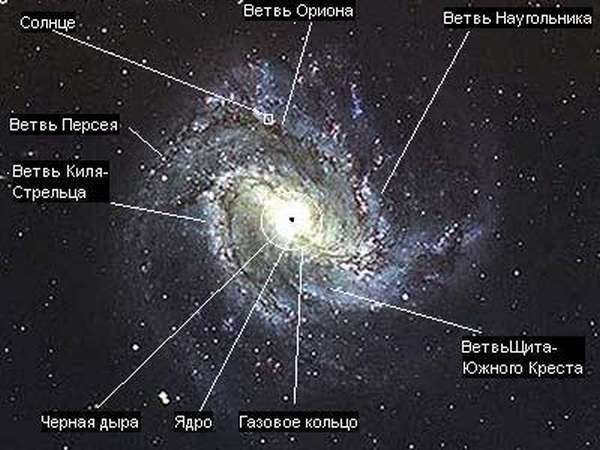
A star is a celestial body that emits immense amounts of light and heat.
It primarily consists of helium (Latin: Helium) and hydrogen (Latin: Hydrogenium).
The celestial body remains in a state of balance due to the pressure within itself and its own gravitational force.
Heat and light are emitted as a result of thermonuclear reactions occurring internally.
What are the various types based on their life cycle and structure:
- Main sequence. This represents the fundamental life cycle of a star. The Sun and the majority of other stars fall under this category.
- Brown dwarf. A relatively small, faint object with a low temperature. The first one was discovered in 1995.
- A white dwarf is a stellar remnant that forms at the end of a star’s life cycle. As it runs out of fuel, the star begins to shrink until its density is able to balance the force of gravity. At this point, the star stops burning and gradually cools down.
- A red giant is a massive star that has exhausted its core hydrogen fuel and expanded in size. Despite its large size, a red giant is not very hot, with temperatures typically reaching up to 5000 K.
- New stars do not ignite like old stars. Instead, old stars experience a burst of renewed vigor as they approach the end of their lives.
- A supernova is a powerful explosion that occurs during the death of a massive star. It releases an enormous amount of energy and light.
- A hypernova is a type of supernova that is even larger in size and more powerful than a regular supernova.
- Bright blue variables (LBVs) are the largest and hottest stars. They exhibit significant variations in their brightness over time.
- Ultra X-ray sources (ULX) are celestial objects that emit large amounts of X-ray radiation.
- A neutron star is a compact star that is characterized by its rapid rotation and strong magnetic field.
- A binary star system is a unique configuration where two stars orbit around a common center of mass. The two stars can have different sizes.
- Blue stars are known for their high temperature and blue color.
- White-blue stars have a combination of white and blue colors.
- White stars have a white color and are typically hotter than yellow stars.
- Yellow-white stars have a mix of yellow and white colors.
- Golden.
- Tangerine.
- Crimson.
Important! The majority of stars in the sky are complete systems. What we observe as one star may actually be two, three, five, or even hundreds of bodies within the same system.
Star and Constellation Names
Throughout history, stars have captivated our imagination. They have been the subject of both mystical practices (astrology, alchemy) and scientific exploration (astronomy). People have sought them out, measured them, counted them, organized them into constellations, and assigned them names. Constellations are groupings of celestial bodies arranged in specific patterns.
Under certain conditions, the night sky can reveal up to 6 thousand stars from various locations on Earth. These celestial objects have scientific designations, but around three hundred of them also possess personal names that have been passed down through ancient times. Interestingly, many of these stars have Arabic names, which can be attributed to the significant contributions made by Arab astronomers.
During a period known as the “dark ages,” when the Western world was experiencing a decline in intellectual and scientific progress, astronomy flourished in Mesopotamia, followed by China. Arab astronomers not only made new discoveries, but they also renamed celestial bodies that already had Latin or Greek names, leaving a lasting impact on the field of astronomy with their Arabic designations. It is worth noting that while stars often possess Arabic names, constellations tend to retain their Latin names.
The brightness of a star is determined by factors such as its emitted light, size, and distance from Earth. Surprisingly, the brightest star in our sky is not the largest or the most luminous; instead, it is the Sun, which is closest to us.
The most stunning celestial bodies with the highest luminosity. Leading the pack are:
- Sirius (Alpha of the Canis Major constellation),
- Canopus,
- Toliman (Alpha Centauri),
- Arcturus (Alpha Boötis),
- Vega (Alpha Lyrae).
Historical Periods of Naming
We can identify several historical periods during which individuals assigned names to these celestial luminaries.
Prehistoric Era
Since the dawn of civilization, humans have endeavored to comprehend the mysteries of the sky, assigning names to the celestial bodies that grace the night. Only a handful of these ancient names have endured the test of time, with scholars and astronomers from Babylon, Egypt, Israel, Assyria, and Mesopotamia actively engaged in this pursuit.
Ancient Greek Era
The ancient Greeks, while not deeply immersed in the study of astronomy, did bestow names upon a select few celestial objects. Often, they borrowed names from existing constellations or simply assigned names that were already in use. Ptolemy Claudius, a renowned Greek scientist of the 1st to 3rd century AD, compiled and documented the collective astronomical knowledge of ancient Greece and Babylon in his seminal works, “Almagest” and “Tetrabiblos”.
The Almagest (Great Construction) is a thirteen-book work by Ptolemy in which he endeavors to elucidate the composition of the cosmos based on the research conducted by Hipparchus of Nicaea (c. 140 BC). Additionally, Ptolemy provides a enumeration of the designations of several of the most brilliant constellations.
An index of the celestial luminaries delineated in the Almagest.
| Name of stars | Name of constellations | Description, location |
| Sirius | Big Dog | Located in the mouth of the constellation. It is also known as the Dog. It is the brightest star in the night sky. |
| Procyon | Small dog | Found on its hind legs. |
| Arcturus | Magus | Does not conform to the pattern of Volopas. Located below it. |
| Regulus | Leo | Located in the heart of Leo. Also referred to as the Royal. |
| Spica | Virgo | On the left hand. Also known as the Colossus. |
| Antares | Scorpio | Located in the middle. |
| Vega | Lyra | Located on the shell. Another name for Alpha Lyra. |
| Capella | Charioteer | Found on the left shoulder. Also called the Goat. |
| Canopus | Argo’s ship. | Located on the keel of the ship. |
Roman era
During the Roman era, the study of astronomy was a significant focus for the Roman Empire. However, just as this science began to flourish, the decline of Rome ensued, ultimately leading to a decline in scientific advancements. Despite this setback, approximately a hundred stars are still known by their Latin names, although it cannot be guaranteed that these names were bestowed upon them by Roman scholars.
The Arab Period in Astronomy
During the Arab period, the study of astronomy was deeply influenced by Ptolemy’s work, Almagest. The Arabs translated and extensively studied this work, incorporating their own religious beliefs into their understanding of celestial bodies. In doing so, they often replaced the original names of the luminaries with new Arabic names, which were sometimes based on the body’s location within the constellations. As a result, many of these Arabic names have meanings related to body parts such as the neck, leg, or tail.
Below is a table showcasing some of the Arabic names and their meanings, as well as the stars and constellations associated with them:
| Arabic name | Meaning | Stars with Arabic names | Constellation |
| Ras | Head | Alpha of Hercules | Hercules |
| Algenib | Bock | Alpha of Perseus, Gamma of Perseus | Perseus |
| Menkib | Shoulder | Alpha Orion, Alpha Pegasus, Beta Pegasus, |
Beta Ascendant, Zeta Perseus, Phita Centauri.
The Renaissance Era: A Time of Cultural Rebirth

In the 16th century, Europe experienced a renaissance of antiquity, which also led to advancements in science. While Arabic names remained unchanged, there was a trend of combining Arabic and Latin names.
During this time, new celestial clusters were rarely discovered, but existing ones were supplemented with new objects. One notable event was the release of the “Uranometria” star atlas.
Compiled by amateur astronomer Johann Bayer in 1603, this atlas featured artistic depictions of constellations.
One of the most significant ideas he put forward was the concept of assigning names to celestial objects by incorporating the letters of the Greek alphabet. The most radiant entity within a constellation would be designated as “Alpha”, while the less luminous ones would be labeled as “Beta” and so forth, culminating with “Omega”. For instance, the most brilliant star in Scorpius would be referred to as Alpha Scorpius, followed by Beta Scorpius, Gamma Scorpius, and so on.
Our era
Thanks to the introduction of advanced telescopes, a vast array of celestial objects has been uncovered. Instead of being given poetic designations, they are now identified by a combination of numerical and alphabetical codes. However, there are instances where these celestial bodies are given names, often honoring the scientists who first observed them. In fact, it is now possible to purchase the privilege of naming a celestial object to your liking.
Important note: The Sun does not belong to any specific constellation.
Originally, constellations were formations made up of bright stars. Nowadays, scientists use them as markers on the celestial sphere.
The following are the most well-known constellations in alphabetical order:
- Andromeda. Located in the northern hemisphere of the celestial sphere.
- Gemini. The brightest stars in this constellation are Pollux and Castor. It is also a zodiac sign.
- The Big Dipper. This constellation consists of seven stars that form the shape of a dipper.
- Canis Major. It is home to the brightest star in the sky, Sirius.
- Libra. This zodiac constellation consists of 83 objects.
- Aquarius. It is a zodiac constellation and its asterism resembles a water jug.
- Taurus. The most prominent object in this constellation is Capella.
- Lupus. Located in the southern hemisphere.
- Bootes. The brightest star in this constellation is Arcturus.
- Coma Berenices. It consists of 64 visible objects.
- The Raven. Best observed in the middle latitudes.
- Hercules. Comprised of 235 visible entities.
- Hydra. Alphard is the most prominent star in this constellation.
- Dove. 71 objects in the southern hemisphere.
- Canes Venatici. 57 visible entities.
- Virgo. Part of the zodiac, with Spica as its brightest star.
- Dolphin. Visible everywhere except Antarctica.
- Draco. Located in the northern hemisphere, close to the pole.
- Monoceros. Positioned along the Milky Way.
- Ara. 60 stars are visible in this constellation.
- Pictor. Consists of 49 celestial objects.
- Giraffe. Faintly visible in the northern hemisphere.
- Grus. Alnair is the brightest star in this constellation.
- Lepus. Contains 72 celestial bodies.
- Ophiuchus. The 13th sign of the zodiac, but not included in this list.
- Serpens. Comprises of 106 luminaries.
- Goldfish. There are 32 objects that can be seen with the naked eye.
- Indian. A constellation that is barely visible.
- Cassiopeia. Resembling the letter “W” in shape.
- Keel. There are 206 objects in this constellation.
- Whale. Located in the “water” region of the sky.
- Capricorn. A zodiac constellation in the southern hemisphere.
- Compass. There are 43 visible luminaries in this constellation.
- Corma. Located along the Milky Way.
- Swan. Located in the northern part of the sky.
- Leo. A zodiac constellation in the northern part of the sky.
- Flying fish. There are 31 objects in this constellation.
- Lyra. The brightest luminary in this constellation is Vega.
- Foxy. A dim constellation.
- The Little Dipper. Located above the north pole and contains Polaris.
- The Lesser Horse. There are 14 luminaries in this constellation.
- The Lesser Hound. A bright constellation.
- Microscope. Located in the southern part of the sky.
- Fly. Located on the equator.
- Pump. Located in the southern sky.
- Naugol. Passing through the Milky Way.
- Aries. A zodiacal constellation that includes the stars Mezarthim, Hamal, and Sheratan.
- Octant. Positioned at the south pole.
- Eagle. Found at the equator.
- Orion. Contains the bright star Rigel.
- Peacock. Located in the southern hemisphere.
- Sails. Consists of 195 luminaries in the southern hemisphere.
- Pegasus. South of Andromeda, with its brightest stars being Markab and Enif.
- Perseus. Discovered by Ptolemy, with the first object being Mirfak.
- A furnace. Virtually invisible.
- Bird of paradise. Situated near the south pole.
- Cancer. A faintly visible zodiacal constellation.
- Incisor. Located in the southern part.
- Pisces. A large constellation divided into two parts.
- Lynx. Contains 92 visible luminaries.
- Northern Crown. Shaped like a crown.
- At the equator, the sextant is located.
- The grid is composed of 22 objects.
- Antares is the first luminary in Scorpio.
- The Sculptor constellation contains 55 celestial bodies.
- Sagittarius is a zodiacal constellation.
- Taurus, also a zodiacal constellation, has Aldebaran as its brightest object.
- The Triangle constellation consists of 25 stars.
- In the Toucan constellation, the Small Magellanic Cloud is located.
- There are 63 stars in the Phoenix constellation.
- The Chameleon constellation is small and dim.
- Proxima Centauri, the brightest star in Centauri, is the closest to the Sun for us.
- Cepheus is shaped like a triangle.
- The Circulus constellation is located near Alpha Centauri.
- The Clock constellation has an elongated shape.
- The Shield constellation is located near the equator.
- Eridanus is a large constellation.
- The Southern Hydra constellation contains 32 celestial bodies.
- The Southern Corona constellation is faintly visible.
- The Southern Fish constellation consists of 43 objects.
- The Southern Cross. It has the shape of a cross.
- The Southern Triangle. It has the shape of a triangle.
- The Lizard. It does not contain any bright objects.
What are the Zodiac Constellations?
The zodiac constellations are the patterns of stars that the Earth passes through during the year, forming a symbolic circle around the celestial sphere. Interestingly, there are 12 accepted zodiac signs, although the Serpent, which is not considered a zodiac, is also located within this circle.
Please note that there are no constellations.
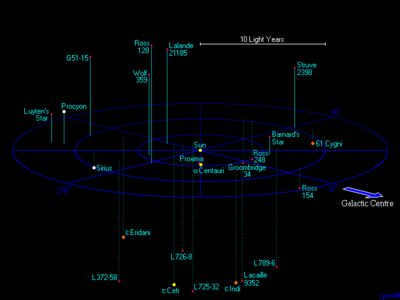
In general, there are no celestial bodies arranged in specific shapes.
When we look at the sky, we perceive it as a two-dimensional plane, but the stars are actually located in three-dimensional space, far apart from each other.
They do not form any specific patterns.
For example, it takes almost 4.3 years for the light from Proxima Centauri, the closest star to the Sun, to reach us.
On the other hand, light from another object in the same star system, Omega Centauri, takes 16 thousand years to reach Earth. These divisions are purely arbitrary.
Map of constellations and stars in the sky, along with interesting facts
Names of stars and constellations
Summary
Calculating the exact number of celestial bodies in the universe is an impossible task. The number is so vast that it cannot be determined accurately. Galaxies are formed when stars come together in clusters. Our own galaxy, the Milky Way, contains approximately 100,000,000,000,000,000,000 stars. With the help of powerful telescopes, we can detect around 55,000,000,000,000,000 galaxies from Earth. Thanks to the Hubble telescope, scientists have been able to discover approximately 125,000,000,000,000,000 galaxies, each containing billions or even hundreds of billions of objects. It is evident that there are at least a trillion trillion trillions of celestial bodies in the universe, but this is only a fraction of what truly exists.

Photo. Author: standret / Shutterstock.com.
The allure of the night sky has captivated and motivated individuals for centuries: the study of celestial bodies began in Babylon during the 6th-4th centuries BC. Babylonian priests developed lunar calendars, astronomical charts, and even predicted solar eclipses. In ancient Egypt, astronomy and astrology were intertwined: the heavenly sun, the Earth’s satellite, and other planets were utilized for prophecy. Pseudoscience coexisted alongside significant scientific breakthroughs: early scientists discovered new stars and bestowed them with poetic labels.
Stars in the Cosmos: The Origins and Legends of Their Creation

The most fascinating names of celestial bodies
- Castor in the Gemini constellation (this star is named after the heroic brother from the myth of Dioscuri);
- Arcturus in the Volopas constellation (the most brilliant star in the northern hemisphere, named after the guardian placed in the sky by Zeus to protect his mother, a nymph who was transformed into a bear by Hera);
- Diadem in the Veronica’s Hair constellation (a fixed celestial body symbolizing the diamond in Berenice’s hair, the queen who offered her locks to the temple of Aphrodite for the sake of her husband’s victory in the war);
- Korneforos in the Hercules constellation (translated as “bearer of the stick”), etc.
During the time of Alexander the Great, Greece experienced its downfall, however, astronomy remained a field that was studied by ancient Roman scientists. The origins of contemporary star names can be traced back to the period when European scientists provided new designations for numerous celestial bodies. As an illustration, they rebranded Izak as Pulcherima, and Zuben Elgenuby as Kiffa Australis (which is a fusion of the Arabic word for “bowl” and the Latin word for “southern”).

How are stars named?
The majority of stars are named using Arabic names, while constellations mostly have Greek and Latin names. The reason for this lies in the dark ages of Europe, a period spanning from the 14th to the 20th centuries, during which Western European countries were preoccupied with disease and war, resulting in a significant decline in scientific advancements. As a result, Europe lagged behind Byzantium, China, and the Muslim world. This is why stars such as Mirah, Alhena, Wasat, and Mebsuta illuminate the night sky. These Arabic names do not carry mythical legends, as astronomers instead assigned verbal characteristics to these celestial bodies, such as “weakness,” “stigma,” “average,” and “elongated.”





